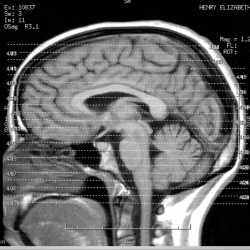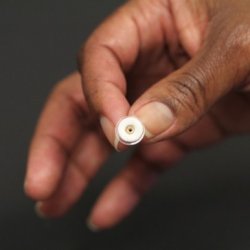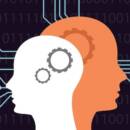Affective Computing: How Empathetic Devices Could Change Your Sex Life
Your emotions are about to get plugged in.

It should be easy to determine whether someone is experiencing a particular emotion. This is what we call empathy and we do it every day. While emotions obviously play a huge role in the things we share using communication technologies, those platforms have never been able to understand what these “emotions” really are.
Affective science, the study of emotion elicitation, emotional experience, and the recognition of emotions in others, is on the brink of changing this and it’s got some really sexy potential.
Who’s making what?
The digital emotion front runner right now is Affectiva, a company that claims to have analyzed facial expressions in over 2 million videos with an emotional detection accuracy of over 90%. This turns out to be better than most humans.
One of Affectiva’s products is the Q-Sensor, a wristband that measures skin conductance, temperature, and motion. The Q-Sensor records these biometrics so its wearer can see at what points during their day they felt emotionally aroused, which means stressed or excited (including, though not limited to, sexual arousal).
Emotient is a competing company that focuses wholly on facial expression recognition technology and claims a 95% accuracy rate. It detects seven primary emotions: joy, surprise, disgust, contempt, anger, sadness, and fear. These are determined based on 20 elementary facial muscle movements.
Another contender in this space is Fraunhofer. In collaboration with Google Glass, Fraunhofer has developed an app for the Google Glass optical headset that also quantifies facial muscle movements to detect emotions, age, and gender from the faces of passersby.
The technology is also being used for sexual purposes. Aside from facial expression, skin conductance, temperature and motion, heart rate is another biometric used to indicate emotional arousal.
An example of its use is the OhMiBod range of remote sex toys. OhMiBod’s heart rate compatible products include a cock ring, G-spot massager, and NEX-1, a flat massaging device that can be put inside a woman’s underwear. These devices can be synced to smartphones and watches that record their owners’ heart rates.
As an OhMiBod user’s heart rate increases, their partner’s device responds by intensifying its operation, which in turn increases that person’s heart rate. This creates what co-founder Suki Dunham calls “this fabulous cycle” of mutual body-tech response where technology creates a stimulation feedback loop between two beating hearts.
This technology may also soon be applied in social and medical settings. Rana el Kaliouby, Affectiva’s founding scientist, has met with companies wanting to give virtual nurses the ability to read faces, integrate emotional recognition into video calling through Skype, and use facial recognition in nightclubs to optimize music and lighting.
This is literally the sort of technology that gave rise to Futurama’s Lucy Liu robot. This robot’s ability to see when Fry was happy or sad meant that it was able to communicate with him on a more than superficial level by responding to his emotional states. This is exactly what facial recognition technology will allow digital interfaces to do in the future.
In Barcelona, a comedy club called Teatreneu decided to use Affectiva’s technology to fight dwindling numbers. They allowed viewers to enter for free on the condition that they pay 30 cents for each laugh as measured by Affdex, which are cameras enabled with Affectiva’s facial recognition software. The initiative was a huge success.
Speech emotion recognition is also fast becoming a digital reality with the work of companies like Emospeech, whose programs can detect modulations in a person’s voice to identify the speaker’s emotional state.
Combined, these advances in emotional technology software and hardware may have incredible outcomes for our sexual futures.
Future sexual scenarios for emotional technologies
With the emergence of all these new technologies that can now bridge the gap between emotional states and digital devices, the potential for sex tech is huge.
So how could emotional technology facilitate better sex in the future?
- The fingertip is one of the primary points for measuring temperature changes and skin conductivity. Sensors on computer mouses could share how aroused online users are with one another.
- Our specifically recognized emotional states could be used to match us with like-minded sexual partners on apps like Grindr and Tinder.
- The MEIT (Mobile Emotional Intelligence Test) app is an emotional IQ test that evaluates emotion and offers emotional intelligence training exercises. We could use emotional intelligence as another sexual compatibility statistic on social media and dating platforms.
- In the future, we could also analyze emotional data from sexual experiences and learn how to better cater to our partners’ (and our own) desires.
- The Xbox One’s HD camera can detect tiny changes in a player’s skin color to calculate changes in heart rate. It can do this with up to 6 players at once. It gauges their emotional states using facial recognition technology similar to that of Affectiva and Emotient. But if the players move, the system can measure how hard individual muscles are working. This technology could be used to create interactive and simultaneous orgies in different countries.
- The crowd orgasm, an idea previously discussed on Future of Sex, could become a global phenomenon with thousands of people around the world connecting remotely and emoting digitally. People could give and receive emotional feedback from physical stimulation.
I’m not alone in envisioning a future enhanced by emotional tech. Affectiva’s Kaliouby predicts the presence of an “emotional chip” in all mobile devices could soon become as ubiquitous as GPS locators. Writing for The New Yorker, Raffi Khatchadorian called these overall tech advancements “the glimmer of an Emotion Economy… the wiring together of all our devices to create ‘ambient intelligence’—an unseen fog of digital knowingness.”
The distinctions between real life, real experience, and real emotion may soon fade thanks to affective computing.
Do you like the idea of your sexual emotions going digital?
Featured image source: Daniel Rehn
2 comments
Leave a reply
You must be logged in to post a comment.


















need it to practice it…being sad, that is.
Care to elaborate?